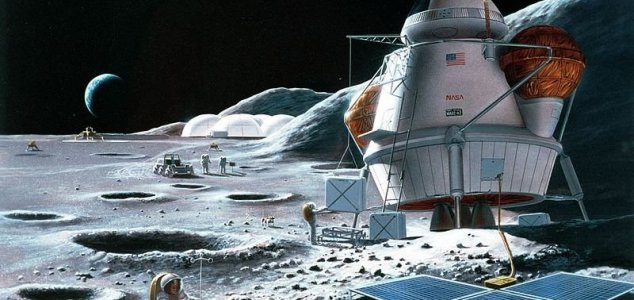Space & Astronomy
January 22, 2020 · 11 comments
11 comments

Another step towards a sustained human presence on the Moon. Image Credit: NASA/SAIC/Pat Rawlings
To this end, scientists at the University of Glasgow in Scotland have come up with a way to produce oxygen from the regolith found on the Moon using a method known as molten salt electrolysis.
It is not the first such technique to have been developed, but it is the most promising, given that alternatives are generally too difficult, too destructive or produce far too little yield to be worth it.
The new method also has the added benefit of producing metal alloys as a waste product.
So far it has proven effective at producing oxygen using a simulant of lunar regolith and plans are now in motion to set up the first ever prototype large-scale oxygen plant at the European Space Agency's European Space Research and Technology Center in the Netherlands.
"Having our own facility allows us to focus on oxygen production, measuring it with a mass spectrometer as it is extracted from the regolith simulant," said chemist Beth Lomax.
"Being able to acquire oxygen from resources found on the Moon would obviously be hugely useful for future lunar settlers, both for breathing and in the local production of rocket fuel."
If everything goes to plan, the team's efforts could lead to the development of a facility that can be set up on the Moon itself to supply future lunar dwellers with all the oxygen they need.
"ESA and NASA are heading back to the Moon with crewed missions, this time with a view towards staying," said ESA's Tommaso Ghidini. "Accordingly we're shifting our engineering approach to a systematic use of lunar resources in-situ."
Source: Science Alert | Comments (11)
New facility to produce oxygen from Moon dust
By T.K. RandallJanuary 22, 2020 ·
 11 comments
11 comments
Another step towards a sustained human presence on the Moon. Image Credit: NASA/SAIC/Pat Rawlings
A new technique could help make it possible for humans to live on the lunar surface in the not-too-distant future.
In order for mankind to live on the Moon or Mars without having to rely on resources sent from Earth, it will be of critical importance to be able to produce the essentials - such as water and oxygen - from the natural resources available on those worlds.To this end, scientists at the University of Glasgow in Scotland have come up with a way to produce oxygen from the regolith found on the Moon using a method known as molten salt electrolysis.
It is not the first such technique to have been developed, but it is the most promising, given that alternatives are generally too difficult, too destructive or produce far too little yield to be worth it.
The new method also has the added benefit of producing metal alloys as a waste product.
"Having our own facility allows us to focus on oxygen production, measuring it with a mass spectrometer as it is extracted from the regolith simulant," said chemist Beth Lomax.
"Being able to acquire oxygen from resources found on the Moon would obviously be hugely useful for future lunar settlers, both for breathing and in the local production of rocket fuel."
If everything goes to plan, the team's efforts could lead to the development of a facility that can be set up on the Moon itself to supply future lunar dwellers with all the oxygen they need.
"ESA and NASA are heading back to the Moon with crewed missions, this time with a view towards staying," said ESA's Tommaso Ghidini. "Accordingly we're shifting our engineering approach to a systematic use of lunar resources in-situ."
Source: Science Alert | Comments (11)

The Unexplained Mysteries
Book of Weird News
AVAILABLE NOW
Take a walk on the weird side with this compilation of some of the weirdest stories ever to grace the pages of a newspaper.
Click here to learn more

Support us on Patreon
BONUS CONTENTFor less than the cost of a cup of coffee, you can gain access to a wide range of exclusive perks including our popular 'Lost Ghost Stories' series.
Click here to learn more
Earth, Natural Disasters and the Environment
Ancient Mysteries and Alternative History
Palaeontology, Archaeology and History
Extraterrestrial Life and The UFO Phenomenon
Total Posts: 7,751,613 Topics: 324,012 Members: 203,511
Not a member yet ? Click here to join - registration is free and only takes a moment!
Not a member yet ? Click here to join - registration is free and only takes a moment!



































Please Login or Register to post a comment.